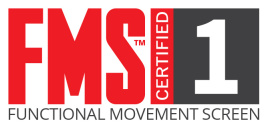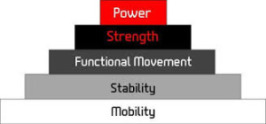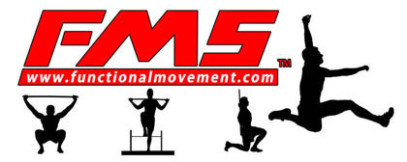Ryan is the area's only certified Functional Movement Professional, he has been utilizing the Functional Movement Screen (FMS) for over 15 years and was taught by the invetor of the FMS Gray Cook. Ryan has performed thousands of screens on people of all ages and abilities. Not only does Ryan perform the screen but he will also educate you throughout the entire process to show you the connections between your movement and any pain or injury you may have or the risk that maybe present. Ryan doesn't stop at the FMS, he adds a secondary assessment to go beyond the FMS to show you where the weakness and compensation is coming from to give you a better understanding of your mobility, stability and movement. Many facilities offer the Screen but I can promise you that you will walk away with more knowledge and understanding of your body than you have ever had before.
"A good auto mechanic will run diagnostics before tinkering with your engine. The same should be true in training and development"
MOBILITY before STABILITY, STABILITY before MOVEMENT, MOVEMENT before STRENGTH, STRENGTH before POWER.
People continuously strive to improve their performance by increasing their flexibility, strength, power and endurance, but in doing so, often sacrifice the level of quality in their fundamental movements. When this occurs, the body will compensate to make up for the poor movement, creating imbalances and physical limitations within the body. If left unchecked, these imbalances and limitations will result in a loss of power, strength, speed and ability to change direction, resulting in a significant decrease in performance
and an increased potential for injury.
The terms mobility and stability are often misunderstood and should be more specifically defined. Mobility is the combination of muscle flexibility, joint range of motion, and a body segment’s freedom of movement. Stability is the ability to maintain posture and/or control motion. Stability can be divided into two categories: static stability and dynamic stability. Static stability is most often assessed during orthopedic testing. Some people will exhibit strong static stabilizers, but weak dynamic stabilizers. These people will compromise their correct movement patterns in order to perform at their highest levels.
People will always sacrifice quality of motion to maintain quantity of motion and in turn develop compensatory movement patterns in order to overcome functional deficits. An example of this is how a person will develop hip stiffness due to athletic or fitness participation. This is a result of the muscle hypertrophy and movement patterns that occur due to training and participation in the gym or in field and court sports. When the hips become stiff in the end ranges of flexion, extension, and adduction, the lumbar spine will have to sacrifice its stability at the expense of greater mobility. Excessive flexion, extension, and rotation will occur at the lumbar spine in an attempt to compensate for a relative decreased stride length during running caused by the stiffness in the hips. Therefore, a person who has a slight decrease in range of motion may not have a great reduction in performance since they will compensate by using poor body mechanics. This compensatory movement pattern is a temporary strategy and although straight-ahead speed may be maintained, the ability to decelerate, cut and avoid obstacles may be altered. This situation will predispose the person to develop micro trauma, or excessive wear and tear on the body.
Testing functional movement allows the client, Dr., coach, trainer, strength & conditioning coach and sports medicine team to understand the interaction between mobility and stability. The combination of poor mobility and stability is the source of many common athletic/fitness problems. People demonstrating poor functional movement patterns should seek to regain these fundamental building blocks before focusing on other attributes of fitness such as strength, speed, power, and endurance. Innumerable unnecessary injuries have occurred because people have focused more on the quantity of their workout statistics (sets, reps, and weight) than the quality and technique of their movements. A common example of this is the squat. Many people will continue to lift greater amounts of weight during training even though they cannot perform a deep, full range-of-motion squat.
Often a person will have high marks in performance testing and low marks in The Functional Movement Screen, indicating that they are functioning on a fine line, predisposing them to a non-contact injury and identifying the fact that they are making significant compensations that will, at best, only temporarily allow for high-level performance. These imbalances in movement will likely lead to micro trauma and chronic injuries throughout the body. The word imbalance indicates that the muscular forces about a certain joint or body segment are not equal, thus creating joint stress and reduced control. A baseball pitcher can be used as an analogy for such an imbalance, considering that the pitch is a repetitive, one-sided rotation and single-arm activity. Imbalances may be identified between the left and right sides of the body as well as the medial/lateral and/or the anterior/posterior aspects of a specific joint.
Where Does Pain & Injury Come From?
"We all have our own individual movement strategies, and as long as the functional
demands upon us don’t frequently or excessively exceed our functional capability, we can be uninjured."
However, if the
functional demands upon us exceed our functional capability and ability to compensate, we become vulnerable to injury.
A good mover has many options and can responsively cope with fluctuations in order to achieve an optimal outcome. He or
she has what we would call a large functional window. They can make the best of a situation, whether it is tripping over a crack in the pavement, lifting a wriggling toddler or just trying something
new.
A poor mover has fewer options. Often their habitual compensations dominate, repetitively driving forces into certain
focal body structures and demonstrating poor adaptability. Their functional window is relatively small. Something unexpected or new is likely to cause stress on the system.
Well balanced training expands the margins of the functional window, making it a little bigger all the time. The body
can accommodate this in small systematic increments. However, should you go too far and too fast beyond your current functional window, you may start to demonstrate coping strategies instead of new
capabilities, leading to potential overload problems
Think of pain as an indicator and warning sign. Much like the warning lights on a dashboard of a car. The light will not go away until you find the WHY and fix the issue, ignore it and eventually it will break down. Most of us have what is called Super-Efficient Dysfunction. This term is used to describe the amazingly efficient ability for people to compensate with dysfunctional movement patterns to accomplish a given task. Meaning we may look globally functional at first glance, but in reality we are master 'movement cheaters' efficiently disguising our dysfunction. The key is to discover the 'cheat' before you get hurt. If you don't discover the cheat, It's not a matter of 'IF' you will get hurt, it's 'WHEN' and how severe!'
TOP CAUSES OF PAIN, INJURY & DECREASED PERFORMANCE
(Micro Traumas, Non-Contact Injuries)
- Previous Injury- If you have had pain, injury or surgery your chance of a repeat injury is significant.
- Training Without Assessment- Lack of assessment of your current ability, weakness, technique, form, proper progression.
- Asymmetrical Movement- Left/Right differences. It is better to be dysfunctional bilaterally (both sides) then it is to have a one sided weakness.
- Dysfunctional Movement- Movement and/or muscle weakness, deficits and imbalance. Dysfunctional movement exists in most people and is accelerated through training, activity and sport.
- Overuse (See the stages of overuse injuries below) - Continued activity on top of dysfunctional movement overtime (i.e. incomplete training, running, performing repetitive exercises with compensatory movements).
- Poor Body Composition- Excess fat weight on top of any of the above causes increase the chance of pain and Injury.
******Any combination of these cause significantly increase the chances of pain and injury.
The Functional Movement Screen
Who needs the FMS?...EVERYONE! If you have back pain, knee pain, shoulder issues, injured, had orthopedic surgery, going through physical therapy, are a female, reconditioning, return to activity or just looking to improve quality of life and improve performance this is where you need to start. The screening includes an individual Functional Movement Screening and secondary muscular activation and strength assessment. This screening will provide a wealth of knowledge in regards to all of your dysfunctions, compensations and weaknesses. An in-depth explanation will be provided throughout the entire testing process.
Testing takes approximately 1.5-2 hours.
Functional Movement Screen (FMS) video
THIS VIDEO IS A MUST WATCH FOR COACHES, PARENTS AND ATHLETES.
One Washington St.
Dover, NH 03820
(By Appointment Only)
Email is the best way to contact me





